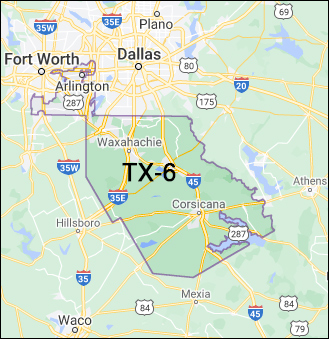By Jim Ellis
May 4, 2021 — Republicans are guaranteed to hold Texas’ vacant 6th Congressional District in the succeeding runoff election as two GOP candidates advanced from the 23-person jungle primary election on Saturday night. Susan Wright, widow of late Congressman Ron Wright (R-Arlington), finished first, as expected, with just over 19 percent of the vote.Accompanying Wright into the runoff contest is freshman state Rep. Jake Ellzey (R-Waxahachie). He scored a vote percentage of 13.9 in slipping past the top Democrat, 2018 congressional nominee Jana Lynne Sanchez, who finished just 354 votes behind in third place.
Ellzey was elected to the legislature in November, but immediately jumped into the congressional race when Rep. Wright passed away. In 2018, Ellzey ran for the 6th District open seat when veteran Rep. Joe Barton (R) retired, finishing second and forcing Rep. Wright, then the Tarrant County Tax Assessor, into a runoff election. Rep. Wright won the runoff 52-48 percent, which was a much closer finish than initially anticipated.
The Saturday night primary proved big for Republicans. Combined, their candidates received 61.9 percent of the 78,374 votes cast according to the initial final count. Democrats finished well below expectations with only a combined 37.3 percent split among their 10 candidates.
These totals are quite different than Rep. Wright’s victory margins in both 2020 and 2018, when he recorded almost identical splits of 53-44 percent and 53-45 percent, respectively. Former President Donald Trump carried the district with a 51-48 percent spread in November but a much stronger 54-42 percent in 2016.






